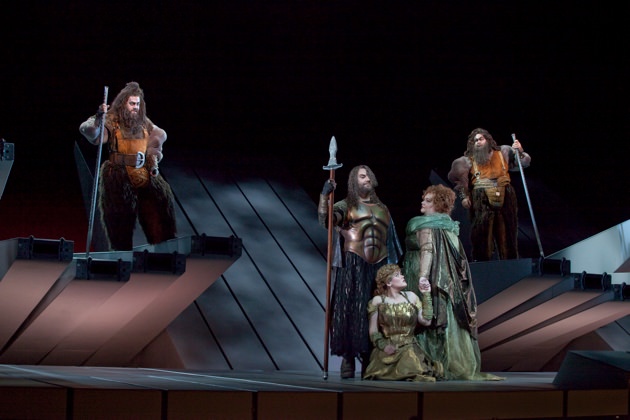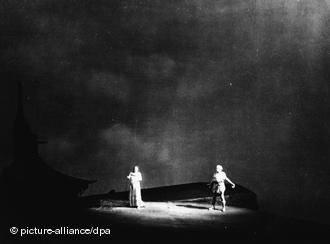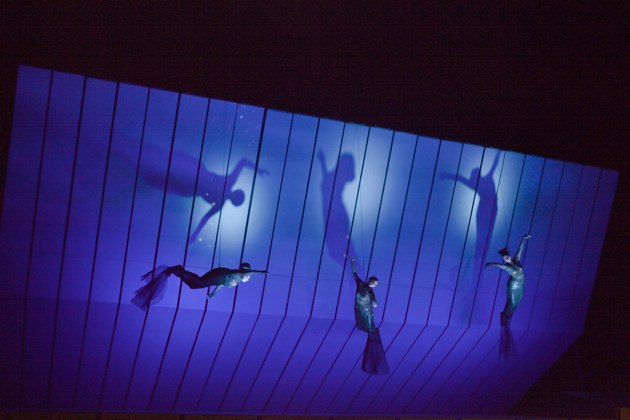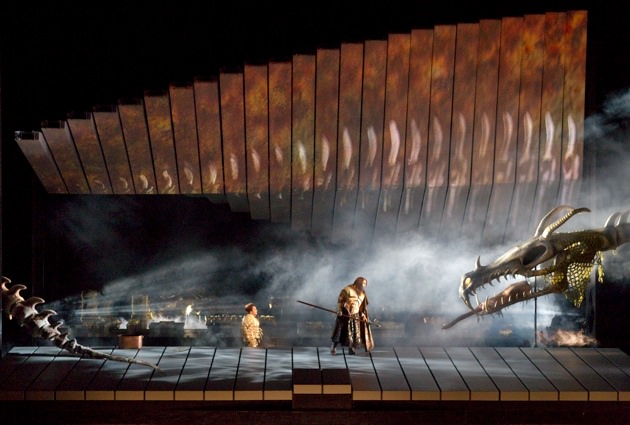What is it about the works of Richard Wagner that consistently inspire some of the most bizarre productions in all of opera? No doubt it is because Wagner’s Der Ring des Nibelungen (1848–1874) poses the nearly impossible challenge of making this monumental four-part music drama accord with ever-shifting notions of the mythic, which change as much as any other fashions.
Therefore it should not be surprising that the first installment of the Metropolitan Opera’s latest Ring cycle—which began this fall with Das Rheingold, the tetralogy’s one-act Vorabend (preliminary evening)—adds yet another contorted realization to the long list of stunt-like Wagner productions over the past half century. In this latest attempt to give contemporary life to the Ring, it is the ponderous stage contraption contrived by the Quebecois set designer Carl Fillon to serve all four of the cycle’s works that commands our attention to the point of distraction.
Peter Gelb, who became the Met’s general manager four years ago, has enlisted figures from other theatrical genres to sweep away the fusty conventions of grand opera, one sure success being the film director Anthony Minghella’s acclaimed 2006 staging of Madama Butterfly. For the new Ring, Gelb has engaged the Quebec-based Robert Lepage, who has devised multi-media spectacles for various opera and theater companies, including Cirque du Soleil (where Fillon is set and props designer), for the 2009 revival of Berlioz’s La damnation de Faust. Although the production was dominated by a towering, static unit set of gridded scaffolding within the squares of which much of the action was confined, this Damnation was a busy affair, with video projections and whirling acrobats that imparted an antic air more Cirque than sacre.
In recent decades, Met Wagner productions have moved away from the conservative representational mode typified by Otto Schenk’s 1986–1988 Ring—its fortress ramparts had the size, solidity, and texture of the Great Wall of China—which remained in use until last year. With such more-or-less minimalist presentations as Robert Wilson’s Lohengrin (1998) and Dieter Dorn’s Tristan und Isolde (1999) the company embraced a direction praised by the Wagner biographer Ernest Newman, who in 1951 wrote of the first postwar Ring produced by Wieland Wagner at his grandfather’s theater in Bayreuth:
The general handling of the action, in combination with the impression of timelessness and spacelessness … did away with the necessity of much of the woeful stuff that currently passes for acting in the Wagner operas. Most of what is required in the way of tracking out subtle psychological nuances is done by the music….(The) production showed that the greatest actor in these Wagnerian dramas is the orchestra.
That last observation rings true in the new Rheingold, the undoubted stars of which are the conductor, James Levine, and the Met orchestra, who deliver a richly detailed account, notably brisker than Levine’s usual dilatory Wagner readings. The musicians, whom Levine has molded into perhaps the world’s finest opera ensemble, here perform with extraordinary finesse, appropriate power, and judicious balance.
The cast is strong almost without exception. Stephanie Blythe is in majestic voice and dramatically persuasive as Fricka, consort of Wotan, foremost among the gods. Alberich the Nibelung, whose theft of the Rhinegold sets the plot in motion, is grippingly portrayed by Eric Owens (though his German diction is not the clearest). And Richard Croft is splendidly full-throttle as Loge, the demi-deity of fire.
The major disappointment is Bryn Terfel, whose first Met Wotan was eagerly awaited. Magnificent in Mozart, Terfel here seems to have hit a wall. At the third performance he started out tentatively, shouted at times, and in some passages sounded remarkably unmusical. One fears he will have a rougher time next spring at the Met with the even more demanding Wotan of Die Walküre.
None of the singers is helped by François St. Aubin’s costumes. Blythe looks as if she had recycled one of Montserrat Caballé’s décolleté concert gowns, whereas Terfel is decked out in an ankle-length skirt, with a high-definition golden breastplate straight out of some 1950s Technicolor Roman epic. Particularly unfortunate is the stringy wig that obscures half his face, making him resemble a Viking Veronica Lake.
Looming throughout is Fillon’s vast stage apparatus. Dubbed “the Machine” by the backstage crew, it consists of two dozen gray-painted vertical planks electronically programmed to pivot up and down along a lateral crossbar like closely aligned seesaws.
Unit sets seldom satisfy all the dramaturgical needs of a production with equal success. Fillon’s 45-ton gadget—which required the floor of the Met stage to be reinforced with steel girders—can be reconfigured into multiple forms, but Rheingold immediately exposed the set’s flaws.
Advertisement
Apart from clanking noisily during scene changes and ruining the composer’s dreamlike transitional music, the Machine malfunctioned on opening night. In the climactic final scene—the entry of the gods into Valhalla—it failed to form the Rainbow Bridge on which the deities march triumphantly toward their new heavenly home. Stranded, they slinked sheepishly into the wings.
Although that mishap was corrected by the time I attended, the Machine nonetheless impedes many exits and entrances. Body doubles for several of the characters slide onstage belly-down on the raked surface of the Machine, like children sledding on Flexible Flyers.
When the goddess Freia is taken by the twin giants Fasolt and Fafner as ransom for Wotan’s unpaid debt for their construction of Valhalla, she helpfully hops backwards up into their clutches from a lower level of the set to a higher one. The rapine thus seems less abduction than elopement.
Other stage business is equally dubious. The monster that Alberich morphs into to demonstrate the transformative powers of the Rhine gold is evoked by a Tyrannosaurus rex fossil wheeled on and off in a perfunctory manner. I have seen scarier dragons in Chinese New Year’s parades. The three Rhinemaidens, in traditional form here as mermaids, are suspended in midair by guy wires, but their flailing movements look less like swimming than the death throes of moths pinned to a board. In an age of cinematic digital wizardry, such heavy-handed stage effects are best omitted.
In light of Lepage’s shenanigans, one could not help but think back to the New Bayreuth Style of the 1950s. The then-recent memory of Hitler’s virtual Putsch at Bayreuth in which he co-opted the Ring as a metaphor for his vision of a master race, rendered the cycle political poison in the immediate aftermath of World War II.
When the annual Bayreuth Festival was finally allowed to resume, in 1951, every aspect of the new production was subject to intense ideological scrutiny. Because of that contingency (as well as a dire lack of funds) Wieland Wagner adopted a minimalist approach that eschewed anything that might be misinterpreted politically.
However, in doing so he did not arrive at some bland nowhere-land, but instead achieved a sublimity akin to the cosmic simplicity of George Balanchine’s near-contemporaneous “black-and-white” ballets. In both instances, a backdrop of solid celestial blue implied a universality far more convincing than either traditional or experimental stage effects.
Even if one does not hew to that rigorously pared-down standard, the Met’s new $16-million Ring seems wildly wasteful, especially in contrast to the Kirov Opera’s far less costly version staged by Valery Gergiev and seen at the Met in the summer of 2007. Though that production at times looked sadly cut-rate, it nonetheless displayed far more imagination and inventiveness than Lepage’s lumbering Myth of the Machine.






